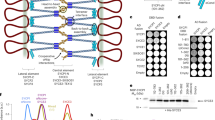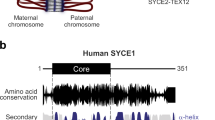Abstract
In many organisms completion of the first meiotic cell division depends on the correct assembly and disassembly of the synaptonemal complex (SC). This is a structure discovered a little over 50 years ago, which is formed by the close association of axes of homologous sister chromatid pairs. Its structure varies between organisms, although it retains a common tripartite organization in species as evolutionarily distant as budding yeast and humans. In mammals it is essential for crossover formation and completion of meiosis. Components of the mammalian SC have been identified only in the last 15 years, and mouse genetic approaches have started revealing the importance for this structure only in the past 5 years. Here we discuss the progress that has been made in the field of the mammalian SC and what approaches could be considered for its further study.
Article PDF
Similar content being viewed by others
Explore related subjects
Discover the latest articles and news from researchers in related subjects, suggested using machine learning.Avoid common mistakes on your manuscript.
References
Agarwal S, Roeder GS (2000) Zip3 provides a link between recombination enzymes and synaptonemal complex proteins. Cell 102: 245–255.
Bolcun-Filas E, Costa Y, Speed R et al. (2007) SYCE2 is required for synaptonemal complex assembly, double strand break repair, and homologous recombination. J Cell Biol 176: 741–747.
Borner GV, Kleckner N, Hunter N (2004) Crossover/noncrossover differentiation, synaptonemal complex formation, and regulatory surveillance at the leptotene/zygotene transition of meiosis. Cell 117: 29–45.
Chua PR, Roeder GS (1998) Zip2, a meiosis-specific protein required for the initiation of chromosome synapsis. Cell 93: 349–359.
Costa Y, Speed R, Ollinger R et al. (2005) Two novel proteins recruited by synaptonemal complex protein 1 (SYCP1) are at the centre of meiosis. J Cell Sci 118: 2755–2762.
Crackower MA, Kolas NK, Noguchi J et al. (2003) Essential role of Fkbp6 in male fertility and homologous chromosome pairing in meiosis. Science 300: 1291–1295.
de Boer E, Stam P, Dietrich AJ, Pastink A, Heyting C (2006) Two levels of interference in mouse meiotic recombination. Proc Natl Acad Sci USA 103: 9607–9612.
de Vries FA, de Boer E, van den BM et al. (2005) Mouse Sycp1 functions in synaptonemal complex assembly, meiotic recombination, and XY body formation. Genes Dev 19: 1376–1389.
Eijpe M, Heyting C, Gross B, Jessberger R (2000) Association of mammalian SMC1 and SMC3 proteins with meiotic chromosomes and synaptonemal complexes [In process citation]. J Cell Sci 113: 673–682.
Eijpe M, Offenberg H, Jessberger R, Revenkova E, Heyting C (2003) Meiotic cohesin REC8 marks the axial elements of rat synaptonemal complexes before cohesins SMC1beta and SMC3. J Cell Biol 160: 657–670.
Geijsen N, Horoschak M, Kim K et al. (2004) Derivation of embryonic germ cells and male gametes from embryonic stem cells. Nature 427: 148–154.
Guan K, Nayernia K, Maier LS et al. (2006) Pluripotency of spermatogonial stem cells from adult mouse testis. Nature 440: 1199–1203.
Hamer G, Gell K, Kouznetsova A et al. (2006) Characterization of a novel meiosis-specific protein within the central element of the synaptonemal complex. J Cell Sci 119: 4025–4032.
Hodges CA, Revenkova E, Jessberger R, Hassold TJ, Hunt PA (2005) SMC1beta-deficient female mice provide evidence that cohesins are a missing link in age-related nondisjunction. Nat Genet 37: 1351–1355.
Hubner K, Fuhrmann G, Christenson LK et al. (2003) Derivation of oocytes from mouse embryonic stem cells. Science 300: 1251–1256.
Hunter N, Borner GV, Lichten M, Kleckner N (2001) Gamma-H2AX illuminates meiosis. Nat Genet 27: 236–238.
Keeney S, Giroux CN, Kleckner N (1997) Meiosis-specific DNA double-strand breaks are catalyzed by Spo11, a member of a widely conserved protein family. Cell 88: 375–384.
Kipling D, Wilson HE, Thomson EJ et al. (1996) Structural variation of the pseudoautosomal region between and within inbred mouse strains. Proc Natl Acad Sci USA 93: 171–175.
Klein F, Mahr P, Galova M et al. (1999) A central role for cohesins in sister chromatid cohesion, formation of axial elements, and recombination during yeast meiosis. Cell 98: 91–103.
Lammers JH, Offenberg HH, van Aalderen M et al. (1994) The gene encoding a major component of the lateral elements of synaptonemal complexes of the rat is related to X-linked lymphocyte-regulated genes. Mol Cell Biol 14: 1137–1146.
Lee J, Iwai T, Yokota T, Yamashita M (2003) Temporally and spatially selective loss of Rec8 protein from meiotic chromosomes during mammalian meiosis. J Cell Sci 116: 2781–2790.
Liu JG, Yuan L, Brundell E et al. (1996) Localization of the N-terminus of SCP1 to the central element of the synaptonemal complex and evidence for direct interactions between the N-termini of SCP1 molecules organized head-to-head. Exp Cell Res 226: 11–19.
Maratou K, Forster T, Costa Y et al. (2004) Expression profiling of the developing testis in wild-type and Dazl knockout mice. Mol Reprod Dev 67: 26–54.
Meng X, Lu X, Morris CA, Keating MT (1998) A novel human gene FKBP6 is deleted in Williams syndrome. Genomics 52: 130–137.
Meuwissen RL, Meerts I, Hoovers JM, Leschot NJ, Heyting C (1997) Human synaptonemal complex protein 1 (SCP1): isolation and characterization of the cDNA and chromosomal localization of the gene. Genomics 39: 377–384.
Meuwissen RL, Offenberg HH, Dietrich AJ et al. (1992) A coiled-coil related protein specific for synapsed regions of meiotic prophase chromosomes. EMBO J 11: 5091–5100.
Miyamato T, Sato H, Yogev L et al. (2006) Is a genetic defect in Fkbp6 a common cause of azoospermia in humans? Cell Mol Biol Lett 11: 557–569.
Nasmyth K (2002) Segregating sister genomes: the molecular biology of chromosome separation. Science 297: 559–565.
Nayernia K, Nolte J, Michelmann HW et al. (2006) In vitro-differentiated embryonic stem cells give rise to male gametes that can generate offspring mice. Dev Cell 11: 125–132.
Novak I, Lightfoot DA, Wang H et al. (2006) Mouse embryonic stem cells form follicle-like ovarian structures but do not progress through meiosis. Stem Cells 24: 1931–1936.
Offenberg HH, Schalk JC, Meuwissen RJ et al. (1998) SCP2: a major protein component of the axial elements of synaptonemal complexes of the rat. Nucl Acids Res 26: 2572–2579.
Ollinger R, Alsheimer M, Benavente R (2005) Mammalian protein SCP1 forms synaptonemal complex-like structures in the absence of meiotic chromosomes. Mol Biol Cell 16: 212–217.
Pelttari J, Hoja MR, Yuan L et al. (2001) A meiotic chromosomal core consisting of cohesin complex proteins recruits DNA recombination proteins and promotes synapsis in the absence of an axial element in mammalian meiotic cells. Mol Cell Biol 21: 5667–5677.
Prieto I, Suja JA, Pezzi N et al. (2001) Mammalian STAG3 is a cohesin specific to sister chromatid arms in meiosis I. Nat Cell Biol 3: 761–766.
Revenkova E, Eijpe M, Heyting C, Gross B, Jessberger R (2001) Novel meiosis-specific isoform of mammalian SMC1. Mol Cell Biol 21: 6984–6998.
Revenkova E, Eijpe M, Heyting C et al. (2004) Cohesin SMC1 beta is required for meiotic chromosome dynamics, sister chromatid cohesion and DNA recombination. Nat Cell Biol 6: 555–562.
Revenkova E, Jessberger R (2005) Keeping sister chromatids together: cohesins in meiosis. Reproduction 130: 783–790.
Rogakou EP, Pilch DR, Orr AH, Ivanova VS, Bonner WM (1998) DNA double-stranded breaks induce histone H2AX phosphorylation on serine 139. J Biol Chem 273: 5858–5868.
Schalk JA, Dietrich AJ, Vink AC et al. (1998) Localization of SCP2 and SCP3 protein molecules within synaptonemal complexes of the rat. Chromosoma 107: 540–548.
Schmekel K, Meuwissen RL, Dietrich AJ et al. (1996) Organization of SCP1 protein molecules within synaptonemal complexes of the rat. Exp Cell Res 226: 20–30.
Stouffs K, Lissens W, Tournaye H, Van Steirteghem A, Liebaers I (2005) SYCP3 mutations are uncommon in patients with azoospermia. Fertil Steril 84: 1019–1020.
Sym M, Engebrecht JA, Roeder GS (1993) ZIP1 is a synaptonemal complex protein required for meiotic chromosome synapsis. Cell 72: 365–378.
Sym M, Roeder GS (1995) Zip1-induced changes in synaptonemal complex structure and polycomplex assembly. J Cell Biol 128: 455–466.
Tarsounas M, Morita T, Pearlman RE, Moens PB (1999) RAD51 and DMC1 form mixed complexes associated with mouse meiotic chromosome cores and synaptonemal complexes. J Cell Biol 147: 207–220.
Toure A, Clemente EJ, Ellis P et al. (2005) Identification of novel Y chromosome encoded transcripts by testis transcriptome analysis of mice with deletions of the Y chromosome long arm. Genome Biol 6: R102.
Toyooka Y, Tsunekawa N, Akasu R, Noce T (2003) Embryonic stem cells can form germ cells in vitro. Proc Natl Acad Sci USA 100: 11457–11462.
Tsubouchi T, Zhao H, Roeder GS (2006) The meiosis-specific Zip4 protein regulates crossover distribution by promoting synaptonemal complex formation together with Zip2. Dev Cell 10: 809–819.
Wang PJ, Mccarrey JR, Yang F, Page DC (2001) An abundance of X-linked genes expressed in spermatogonia. Nat Genet 27: 422–426.
Xu H, Beasley MD, Warren WD, van der Horst GT, McKay MJ (2005) Absence of mouse REC8 cohesin promotes synapsis of sister chromatids in meiosis. Dev Cell 8: 949–961.
Yang F, Fuente RL, Leu NA et al. (2006) Mouse SYCP2 is required for synaptonemal complex assembly and chromosomal synapsis during male meiosis. J Cell Biol 173: 497–507.
Yuan L, Liu JG, Hoja MR et al. (2002) Female germ cell aneuploidy and embryo death in mice lacking the meiosis-specific protein SCP3. Science 296: 1115–1118.
Yuan L, Liu JG, Zhao J et al. (2000a) The murine SCP3 gene is required for synaptonemal complex assembly, chromosome synapsis, and male fertility. Mol Cell 5: 73–83.
Yuan L, Liu JG, Zhao J et al. (2000b) The murine SCP3 gene is required for synaptonemal complex assembly, chromosome synapsis, and male fertility. Mol Cell 5: 73–83.
Zhang W, Zhang SZ, Xiao CY et al. (2005) [Possible association between 278C/A single nucleotide polymorphism of FKBP6 and idiopathic azoospermia]. Zhonghua Yi Xue Yi Chuan Xue Za Zhi 22: 10–13.
Author information
Authors and Affiliations
Corresponding author
Rights and permissions
About this article
Cite this article
Costa, Y., Cooke, H.J. Dissecting the mammalian synaptonemal complex using targeted mutations. Chromosome Res 15, 579–589 (2007). https://doi.org/10.1007/s10577-007-1142-1
Published:
Issue Date:
DOI: https://doi.org/10.1007/s10577-007-1142-1




